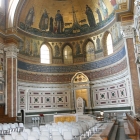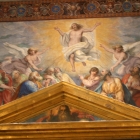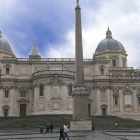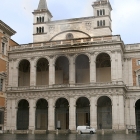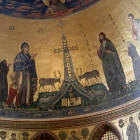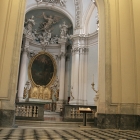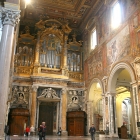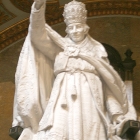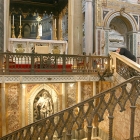San Giovanni Laterano, the real cathedral of Rome
When people hear “the cathedral of Rome” usually think of St Peter’s Basilica in the Vatican, from where the Pope delivers the Easter benediction. Well, in fact St Peter’s is not a cathedral at all, it’s a “regular” church, despite its architectural and historical value. The term cathedral comes from the Latin word for seat, and refers to the armchair on which the local bishop sits during the religious service. The seat of the bishop of Rome, which is the Pope, is not found in St Peter’s Basilica, but a few kilometers away, in St John’s cathedral of Lateran. The cathedral is dedicated to John the Baptist and John the Evangelist. Since the Pope claims authority over the entire Christian world, the place has ecumenical significance, with the papal throne assimilated to a center point of the Catholic (meaning “universal”) church. Of course, this view is less popular in the Orthodox and Protestant world.
The history of the Lateran palace and basilica goes back a very long way and is quite impressive. The name itself comes from a noble family in the ancient Rome that had its palace here. The former palace of the Laterani family was given to the bishop of Rome by emperor Constantine the Great, who made Christianity a legal religion in the Roman empire. In the square in front of San Giovanni in Laterano there is the tallest Egyptian obelisk in Rome, that surpasses the one in the San Pietro square. The obelisk from the time of pharaohs Tutmosis III and IV is today the largest intact Egyptian obelisk in the entire world. At its base there is an inscription commemorating the first Christian emperor of the Roman Empire: “Constantinus per crucem victo as silvestro hic baptizatus crucis gloriam propagavit”. The emperor saw the sign of the cross in the sky before a decisive battle for succession with the Latin words: “In hoc signo vinces” (In this sign you will triumph). He then put an end to state persecutions against Christians and baptized before his death.
Conspiracy theorists claim that the obelisks, coming from the Babylonian religion, are phallic symbols of the pagan religion carried on by gnostics and free-masons as their symbols as the pyramids. Obelisks can be seen in numerous public squares including at the Vatican, some dating from the time when Rome ruled over Egypt, as is the case with those from Rome and Constantinople (Istanbul).
The reconstructed basilica and palace are the work of architect Domenico Fontana and later Francesco Borromini and Alessandro Galilei. The focus point when entering the cathedral of Laterano is the Gothic baldachin over the high altar, made by Giovanni di Stefano. The baldaquin has golden stars sewed over a blue sky of silk. Descending a few marble steps under it you can see the statue of John the Baptist.
The see of the pope (cattedra papale) is found in an abside under a semicircular Byzantine mosaic. Under the image of the Lord, the central symbol is the cross and the dove of the Holy Ghost. On the sides of the cross, the Virgin Mary, Paul, Peter, Andrew, John the Baptist and John the Evangelist pay homage accompanied by animals that symbolize the creation.
One of the ancient elements that survive from the old palace of Lateran is the Holly Ladder. The staircase is said to be taken from the pretorium of Pilate in Jerusalem, thus being the stairway on which Jesus Christ stepped when being brought to trial. The staircase was brought to Rome by empress Helen, the mother of Constantine, one of the first pilgrims in history. The legend says that the empress brought not only this staircase, but also the wood of the cross from Jerusalem.
The marble floor in St John’s archbasilica has a black and white pattern that from some angles create the optical illusion of three dimensional pattern. Very large statues of the apostles are found along the walls that support the main nave of the church. On one side, a large fresco depicts the ascension of Christ. The plan of the basilica, in the shape of a cross has a span of 140 m.
Mai multe despre: Italia, Religious architecture • cathedral • cathedral of Rome • catholic • Constantine the Great • Italia • Italy • obelisk • Roma • Rome • San Giovanni in Laterano • St John Lateran- Home Page
start page - Architecture
landmark buildings - Sacred architecture
places of worship - Nature
landscape photography - Concert
performing artists - Christmas
Santa Claus pictures
- Jooble
jobs for photographers - Escape
an out of control blog - Merry Christmas
The best organizer of Christmas parties - Astro photo
Eclipse hunting and astrological photography






